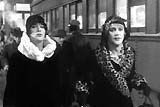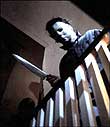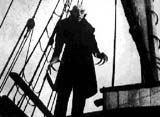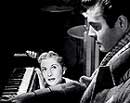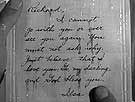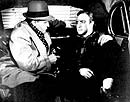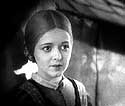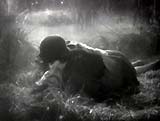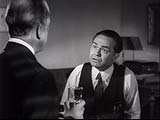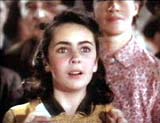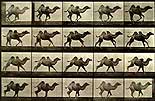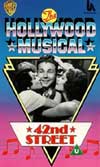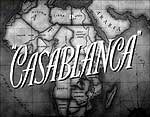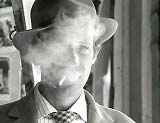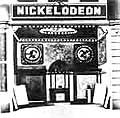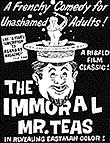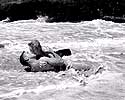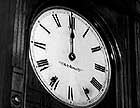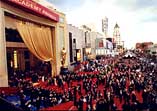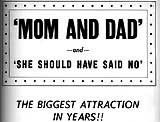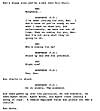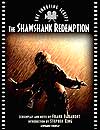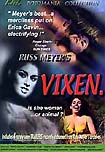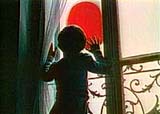| Film Terms Glossary |
| Cinematic Terms | Definition and Explanation | Example (if applicable) |
omniscient
point-of-view
(POV) | a film in which the narrator knows (and sees) everything occurring in a story, including character thoughts, action, places, conversations, and events; contrast to subjective point-of-view | |
on or onstage
(or on-camera) | on the visible stage, or within the boundaries of the camera's field of vision | |
| one-liner | a term for a short, one-line joke (that contains its own punchline); also the term may refer to the 'high concept' description of a film - a few words used to describe a script, storyline or a film's premise that a person can easily understand with a simple one-liner | Examples: (comedic one-liner): "Either he's dead or my watch has stopped!" (Groucho Marx in A Day At the Races (1937)), and (high concept one-liner): "A teenager is mistakenly sent into the past, where he must make sure his mother and father meet and fall in love; he then has to get back to the future." Back to the Future (1985) |
| one man (or woman) show | a scripted or filmed narrative (or an avant-garde or experimentalfilm) featuring a solo performance piece with only one actor or actress who sometimes plays multiple roles or characters; often presented by a stand-up comedian; contrast with concert film | Examples: Give 'em Hell, Harry! (1975), Paul Robeson (1977), Gilda Live (1980), Secret Honor (1984), Whoopi Goldberg Live (1986), Swimming to Cambodia (1987)(by Spalding Gray), The Search for Signs of Intelligent Life in the Universe (1991) (with Lily Tomlin), and Eric Bogosian's Sex, Drugs, Rock & Roll (1991) |
| one-reeler | refers to a film 10-12 minutes long | |
| one-sheet | refers to the typical size of a movie poster | |
| opening credits or title (sequence) | the presentation of the 'opening credits' (as an introduction to the audience about the film and including selected important members of the production) is known as the opening credits sequence; sometimes it is superimposed on the action, but often exists as static letters on a solid background; since the closing or end credits usually list the entire cast and production crew, the opening credits sequence is usually positioned to set the mood of the film, and sometimes even lacks any credits except the film's title
|  Examples: Saul Bass was famous for his opening credits sequences, such as his work on Hitchcock'sNorth By Northwest (1959) with crisscrossing lines that turned into the side of a building; Examples: Saul Bass was famous for his opening credits sequences, such as his work on Hitchcock'sNorth By Northwest (1959) with crisscrossing lines that turned into the side of a building;
 the opening of Woody Allen'sManhattan (1979) was credit-less save for a flashing "Manhattan" sign on a building; the opening of Woody Allen'sManhattan (1979) was credit-less save for a flashing "Manhattan" sign on a building;
 and James Cameron's The Abyss (1989) featured the title emerging from blackness and traveling down the "Y" into the ocean and James Cameron's The Abyss (1989) featured the title emerging from blackness and traveling down the "Y" into the ocean
Robocop 2 (1990) and Vanilla Sky (2001) were unusual in that there were no opening credits of any sort, not even the title of the film - an increasing trend! |
optical(s)
(or optical effects) | in film-making, refers to a visual device, e.g., a fade, wipe,dissolve, superimposition, freeze-frame, split-screen,composite (a train reflection in a car window), or another effect, some of which can be created in the camera, and others that have to be achieved in post-production by mixers or other specialized techniques | Example: Star Wars (1977) mimicked the Saturday matinee style of episodic serials with various opticals |
| Oscar(s) | the name given to the awards of AMPAS (the Academy of Motion Picture Arts and Sciences) given each year to various performers and others in the film industry; officially known as the "Academy Award of Merit" | 
The 13.5 inch award statuettes were officially nicknamed Oscars after 1939 |
| Oscar bait | Often used in a derogatory way to describe studio-invented pre-release PR buzz that a film (usually an epic or serious biopic released late in the year) is worthy, meaningful, and deserving of Oscar awards; the term was reportedly first used by Hedda Hopper in a "Looking at Hollywood" column on June 1, 1948; the term either refers to (1) a self-proclaimed, "important", often over-produced film, undercut by its attempt to appeal to all demographics, or (2) a showy acting performance designed to draw attention to itself; these kinds of films and performances were the sort that used to guarantee an Oscar from Academy voters during the film industry's adolescent years of the 1950's and early 1960's, but are now considered either pretentious and/or cheesy in the modern age, and ironically often hurt the film's or actor's chances at winning an Oscar, though some films still succeed; aka Oscarbation
| Examples: The Alamo (1960) and Chill Wills' campaign for a Best Supporting Actor Oscar was the first major example of "Oscar bait" backlash; also Hello, Dolly! (1969), Paint Your Wagon (1969), The Towering Inferno (1974), Inchon (1982); recent examples include The Last Samurai (2003), Alexander (2004), Memoirs of a Geisha (2005) and The Pursuit of Happyness (2006);Around the World in 80 Days (1956), Gandhi (1982) andThe English Patient (1996) are examples of successful "Oscar bait"; Christopher Guest's For Your Consideration (2006), a mockumentary about movie-making, examined Hollywood's obsession with awards by its story of an indie production titled Home for Purim. |
| out-takes | refers to camera shots that are not included (literally, they are 'taken out') in the final cut or print of a film, often retrieved from thecutting room floor, and shown during the closing credits; also seeblooper | Examples: Films with blooper outtakes at the conclusion during the credits include: Cannonball Run (1981), Liar Liar (1997), A Bug's Life (1998), and Toy Story 2 (1999). |
| overacting | poor, overly-broad, or 'over-the-top' acting by a 'ham' actor; aka "hamming it up" or 'chewing up the scenery'; sometimes considered in a positive light as 'campy'; contrast with underacting | 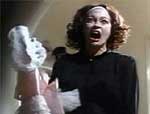 Example: Faye Dunaway inMommie Dearest (1981). Example: Faye Dunaway inMommie Dearest (1981). |
| overcrank | to speed up a camera - to shoot at more than the normal 24 fps, so that the resulting image appears in slow-motion; this technique is often used to shoot miniatures; the term "cranking' refers to the old technique of having to turn or crank a camera by hand | |
| overexposed | refers to a film shot that has more light than normal, causing a blinding, washed-out, whitish, glaring effect; deliberately used for flashbacked or dream scenes; aka flared or bleached; the opposite of underexposed | 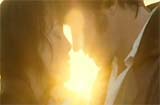 Example: the kissing scene in Pride & Prejudice (2005)before a bright sun Example: the kissing scene in Pride & Prejudice (2005)before a bright sun |
| overlap | the carry-over of dialogue, sounds, or music from one scene to another; occurs when the cut in the soundtrack is not at the same time as the cut in the image; can also refer to two or more characters speaking at the same time; aka overlap sound | Example: Robert Altman's M*A*S*H (1970) |
| over-the-shoulder (OTS) shot | a very commonly-used medium camera angle or view in a dialogue scene, mostly with alternating shot/reverse-shot editing, in which the camera records the action from behind the shoulder and/or head of one of the characters, thus framing the image; the two characters are thus linked or connected to each other, and their positions are established | |
| overture | in film terms, a pre-credits or opening credits musical selection that sets the mood and theme for the upcoming film
| Examples: Most musicals feature an overture (during or before the opening credits) that is comprised of a medley of the main songs of the film, such as West Side Story (1961) and My Fair Lady (1964); some dramatic (or epic) films have overtures as well -- Ligeti'sAtmospheres overture in 2001: A Space Odyssey (1968) precedes the opening credits. Pre-credit overtures are often cut in home and television video releases. |
| ozoner | slang term for a drive-in movie theater; aka passion pit; see alsohard-top (indoor movie theater) | |
| p.a. | abbreviation for 'personal appearance' - often required of major stars - to promote or provide PR (p.r.) or 'public relations' (marketing) for their films | |
| pace | the speed/tempo of the dramatic action, which is usually enhanced by the soundtrack and the speed of the dialogue, the type of editing, etc. | |
| package | the marketing elements of a film project, such as script, signed film stars, director, locations, 'high-concept' hook, etc. | |
| pan | verb meaning 'to express a totally negative opinion of' a film, normally in a critical film review; also known as 'trashing' a film | |
pan
(or panning shot, orpanoramic shot) | abbreviation for panorama shot; refers to the horizontal scan, movement, rotation or turning of the camera in one direction (to the right or left) around a fixed axis while filming; a variation is theswish pan (also known as flash pan, flick pan, zip pan, blur pan, or whip pan), in which the camera is purposely panned in either direction at a very fast pace, creating the impression of a fast-moving horizontal blurring of images across the screen; often confused with a dolly or tracking shot. |  Examples: the call to roundup as the camera moves around and captures the faces of the cowpokes in Red River (1948); in John Ford's Stagecoach (1939) a panning shot reveals the presence of Indians just as the stagecoach seems to be heading to safety; and many films utilizing theswish pan -- a fast blurring panning action that blends two scenes together (signifying rapid movement from one place to the next). Examples: the call to roundup as the camera moves around and captures the faces of the cowpokes in Red River (1948); in John Ford's Stagecoach (1939) a panning shot reveals the presence of Indians just as the stagecoach seems to be heading to safety; and many films utilizing theswish pan -- a fast blurring panning action that blends two scenes together (signifying rapid movement from one place to the next). |
| pan and scan | a technique that avoids the 'letterboxing' of a widescreen film for a full-framed 4x3 home video or TV picture, by focusing on the elements of the picture that are most important to the plot and by adjusting or cropping the image; when an important part of the image drops out of the visible screen, the picture is mechanically panned to the side (left or right in a ping-pong effect) to show the missing part - hence, the term pan-and-scan; approximately 43% of the visuals are sacrificed or cropped out in the pan-and-scan version, affecting the director's original intent and aesthetic sense |  Example: from the film Out of Sight (1998), with the yellow box showing the selected "pan and scanned" window or 4 x 3 image; Example: from the film Out of Sight (1998), with the yellow box showing the selected "pan and scanned" window or 4 x 3 image;

"Pan and scan" encounters major problems, as in the climactic show-down cemetery scene in The Good, the Bad, and the Ugly (1966), when the image takes up the entire screen
|
parallel
(editing, action, sound, etc.) | editing that cuts between two sequences taking place at different locations and possibly different times; parallel action refers to a narrative device in which two scenes are observed in parallel by cross-cutting; parallel sound refers to sound that matches the accompanying image; aka cross-cutting, inter-cutting | |
| parody | a comedy that imitates or makes fun of an existing work(s) in an absurd, non-sensical way, and exaggerates its characteristics | Examples: Airplane! (1980) - a parody of disaster films;Blazing Saddles (1974) - a parody of westerns. |
| payoff | a dramatic scene that justifies everything that preceded it; the necessary result of a complication for which the audience has been prepared; contrast to punchline and money shot | Example: the startling scene with an admission of incest ("She's my sister and my daughter!") by Evelyn Mulwray (Faye Dunaway) in Chinatown (1974) |
| payola | refers to bribery or under-the-table payments | |
| persona | literally, Latin for "mask"; related to the on-screen image or personality associated with a star | Examples: Mae West: a sexually-bold vamp with one-liners filled with sexual innuendo; Groucho Marx: a sly, witty, irreverent, sarcastic insult-spewing, wisecracking scam artist |
| pic(s) (also pix) | slang terms for motion picture(s) | |
| picture within a picture | a particular story-telling approach, literally, to have one film within another; in some cases, the characters are aware of the 'film-within-a-film,' and break the fourth wall and enter into or interact with it; aka subset film or film within a film |  Example: the newsreel of Kane's life "News on the March" in Citizen Kane (1941), homage to the real "The March of Time" newsreel Example: the newsreel of Kane's life "News on the March" in Citizen Kane (1941), homage to the real "The March of Time" newsreel |
| pin-up girl | refers to the most sexually-attractive star-actresses of an era, who would be popularized in seductive poses usually semi-clad - in pictures, calendars, or mass-produced posters that were usually literally "pinned-up", usually with thumbtacks, on bedroom walls, the insides of lockers, and so forth; this practice started especially amongst GI servicemen away from home during military combat who pined for the 'girl-back-home'; related terms are cover girl (for magazine covers), model or cheesecake
| 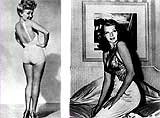 Examples: Betty Grable, Rita Hayworth, Betty Page, Marilyn Monroe, Raquel Welch, Brigitte Bardot, Bo Derek, Farrah Fawcett Examples: Betty Grable, Rita Hayworth, Betty Page, Marilyn Monroe, Raquel Welch, Brigitte Bardot, Bo Derek, Farrah Fawcett |
| pitch(es) | orally or written (sales) proposals for film projects usually made by screenwriters (to sell a screenplay idea), or independent producers for studio producers or executives to obtain financial backing; anything from a one-line description to a two- to three-pagetreatment of an idea (before becoming a script); also refers to short phrases that capture or succinctly sum up the script | Examples: Jaws (1975): Man afraid of water pursues killer shark; or E.T.: The Extra-Terrestrial (1982): Loveable alien is left behind; or Toy Story (1995): Toys come to life |
| pivotal character | refers to the character that launches the action between theprotagonist and the antagonist; or the character who sets the main events of the plot in motion; films with a classic "love triangle" involve a woman who serves as the 'pivotal character' between two rival suitors
| |
| pixillation | an animation technique in which the illusion of continuous, real movement of three-dimensional objects, often people, is broken and/or made to move unevenly or jerky through the use of stop-action cinematography (single frame animation) or by printing only selected frames from the continuously-exposed negative |  Example: the infamous eating scene in Tom Jones (1963) Example: the infamous eating scene in Tom Jones (1963) |
plot and
plot point | refers to a series of dramatic events or actions that make up a film'snarrative; a plot point is a key turning point or moment in a film's story that significantly advances the action; plot points either set the story further into motion, or disrupt and complicate the plot; also known as beat or A story; contrast to a subplot (aka B story or C story) - a secondary plot in a film; a plot plant is the technique of 'planting' an apparently trivial piece of information early in a story - that becomes more important later on | |
point of view
(POV) | the perspective from which the film story is told; also refers to a shot that depicts the outlook or position of a character; also seeomniscient and subjective point of view, and P.O.V. shot | |
P.O.V. shot
(or point-of-view shot) | a subjective shot made from the perspective of one of the characters to show the audience the scene as it would look through the character's eyes; usually coupled (before and/or after) with areaction shot (or a three-shot sequence called a shot reverse shot) to establish the POV; also known as first-person point-of-view shot or subjective camera (the use of the camera to suggest the POV of a particular character) |  Examples: Hitchcock's Rear Window (1954) Examples: Hitchcock's Rear Window (1954)
 or the serial killer's POV (with night goggles) in The Silence of the Lambs (1991) or the serial killer's POV (with night goggles) in The Silence of the Lambs (1991)
|
| porn (porno) | refers to a film that exploits sex; see also nudie | |
| post-credits sequence | either a throwaway scene or an epilogue that happens during or after the end credits; sometimes used as a bonus for theatergoers who remain to watch the credits, and partly to generate 'buzz' about the extra scene |  Examples: Airplane! (1980)has the most famous example of a post-credits sequence when taxi passenger (politician and income-tax fighter Howard Jarvis), who was abandoned by Ted Striker (Robert Hayes) -- but with the meter still running, checks his watch and huffs with one final punchline: "Well, I'll give him another 20 minutes, but that's it!"; other films include Young Sherlock Holmes (1985), Angel Heart (1987), The Great Outdoors (1988),Cosi (1996), and Pirates of the Caribbean: The Curse of the Black Pearl (2003). Many films have post-credit sequences in the middle of the end credits, such asGremlins 2: The New Batch (1990), Chicken Run (2000), and Shrek 2 (2004) Examples: Airplane! (1980)has the most famous example of a post-credits sequence when taxi passenger (politician and income-tax fighter Howard Jarvis), who was abandoned by Ted Striker (Robert Hayes) -- but with the meter still running, checks his watch and huffs with one final punchline: "Well, I'll give him another 20 minutes, but that's it!"; other films include Young Sherlock Holmes (1985), Angel Heart (1987), The Great Outdoors (1988),Cosi (1996), and Pirates of the Caribbean: The Curse of the Black Pearl (2003). Many films have post-credit sequences in the middle of the end credits, such asGremlins 2: The New Batch (1990), Chicken Run (2000), and Shrek 2 (2004) |
| post-modern | refers to a return to tradition, in reaction to more 'modernist' styles | |
| post-production | the final stage in a film's production after principal photography or shooting, involving editing, the addition of sound/visual effects, musical scoring, mixing, dubbing, distribution, etc.; in digital post-production, can also include changing facial expressions, removing flaws or obtrusive objects (microphone, boom, etc.), enhancing the visual image, etc.; aka post; contrast to pre-production | |
| post-synchronization (akaAutomatic Dialogue Replacement, or ADR, or post synching) | refers to the post-production process of recording the sound after the film has been shot, often adding dialogue spoken by actors as they watch the projected film | |
| potboiler | a literary reference to the hard-edged, American detective/crime thrillers (also often called 'pulp fiction' or 'dime novels') rapidly written and filled with violence, crime, and sex - to literally 'boil the pot'; also known as hard-boiled | Examples: Most of the films based upon Raymond Chandler's, Dashiell Hammett's and Mickey Spillane's film-noirish crime novels, i.e., The Big Sleep (1939),The Maltese Falcon (1941), and Kiss Me Deadly (1955), featuring 'private dicks' and 'femme fatales' |
| pre-Code | refers to the four-five years (1930-1934) before the enforcement of the Hays Production Code in Hollywood, to rigidly sanitize and censor films. In film plots from mid-1935 and lasting about the next 30 years, adultery and promiscuity were prohibited (unless they ended in a miserable downfall), and all crimes (and their criminals) had to be punished. | Examples: pre-Code films included Night Nurse (1931),Queen Christina (1933), Baby Face (1933), and The Gold Diggers of 1933 (1933). See History of Sex in Cinema for more. |
| premiere | the first official public screening of a movie, marking the kick-off, opening or opening night; a 'red carpet' premiere is one with greater publicity and hoopla (sensational promotion), ballyhoo, or hype; aka a bow, debut, or preem | |
| premise | the main idea of a movie, usually explainable in a few sentences
| |
| pre-production | the planning stage in a film's production after the project is finallygreenlighted, and before principal photography or actual shooting commences, involving script treatment and editing/rewriting, scheduling, set design and construction, casting, budgeting and financial planning, and scouting/selection of locations; contrast topost-production | |
| prequel | the second or third film in a series of films that presents characters and/or events that are chronologically set before the time frame of the original movie; contrast to sequel | Examples: Star Wars: Episode I: The Phantom Menace (1999), and Star Wars: Episode II - Attack of the Clones (2002) are both prequels to Star Wars (1977); a combination prequel-sequel film was Coppola's The Godfather, Part II (1974); Another Part of the Forest (1948) was a prequel of The Little Foxes (1941) |
| preview | a short film, usually with excerpts from a future film, intended as an advertisement; a sneak preview refers to an unadvertised, often surprise showing of an entire film before its general release or announced premiere, often to gauge audience reaction; aka trailer | |
| pre-screen | to view/watch/see a movie before it is released for the public (at thepremiere) | |
| principal photography | refers to the filming of major and significant portions of a film production that involves the main/lead actors/actresses; contrast tosecond-unit photography | |
| principals | refers to the main characters in a play or film (usually those that have dialogue); contrasted to protagonists or antagonists, orextras. | |
| print | refers to a positive copy of a film | |
| prison film | a very popular sub-genre with the film's plot usually set within the walls of an institutional prison; themes involve imprisonment and/or escape, the effects on the characters involved and interactions between officers and inmates, and issues of justice/injustice; the prison flick sub-genre can be found in any major genre (animated, drama, comedy, musical, science fiction, sexploitation, etc.) | Examples: The Big House (1930), I Am a Fugitive From a Chain Gang (1932), Brute Force (1947), Stalag 17 (1952), Riot In Cell Block Eleven (1954), The Bridge on the River Kwai (1957), Jailhouse Rock (1957), The Defiant Ones (1958), The Great Escape (1963), Cool Hand Luke (1967), Take the Money and Run (1969), Birdman of Alcatraz (1962), Papillon (1973), Caged Heat (1974), Ilsa: She Wolf of the SS (1975), Midnight Express (1978), Escape from Alcatraz (1979), Stir Crazy (1980), Escape from New York (1981), 48 HRS (1982), Chained Heat (1983), Schindler's List (1993),The Shawshank Redemption (1994), The Rock (1996), The Green Mile (1999), Chicken Run (2000), O Brother Where Art Thou? (2000) |
process
(projection or shot) | a technique that shoots live action in front of a screen on which the background view is projected; a process shot refers to a shot of live action in front of a process projection | |
| producer (film) | the chief of a movie production in all logistical matters (i.e., scheduling, financing, budgeting) save the creative efforts of the director; raises funding and financing, acquires or develops a story, finalizes the script, hires key personnel for cast, crew, and director, and arranges for distributors of the film to theaters; serves as the liaison between the financiers and the film-makers, while managing the production from start to finish. | |
| product placement | refers to how companies buy advertising space within a film for their products, as a way for a producer to fund some film production costs |  Example: the familiar brand names in Kubrick's 2001: A Space Odyssey (1968); Mountain Dew in Antz (1998); or Hershey's Reese's Pieces inE.T.: The Extra-Terrestrial (1982) - when Mars Inc. passed on using M&Ms Example: the familiar brand names in Kubrick's 2001: A Space Odyssey (1968); Mountain Dew in Antz (1998); or Hershey's Reese's Pieces inE.T.: The Extra-Terrestrial (1982) - when Mars Inc. passed on using M&Ms
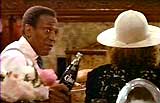 or the blatant placements of Coca-Cola in the company-owned Columbia Pictures' release Leonard Part 6 (1986); or Pampers in Three Men and a Baby (1987); or McDonalds and Coke in Mac and Me (1988); or Exxon in Days of Thunder (1990); or the numerous FedEx product placements in Cast Away (2000). or the blatant placements of Coca-Cola in the company-owned Columbia Pictures' release Leonard Part 6 (1986); or Pampers in Three Men and a Baby (1987); or McDonalds and Coke in Mac and Me (1988); or Exxon in Days of Thunder (1990); or the numerous FedEx product placements in Cast Away (2000).
|
| production | the general process of putting a film together, including casting, set construction, costuming, rehearsals, and shooting; also refers to themiddle stage of production which is preceded by pre-productionand followed by post-production | |
| production design | refers to a film's overall design, continuity, visual look and composition (colors, sets, costumes, scenery, props, locations, etc.) that are the responsibility of the production designer; the art department refers to the people in various roles (e.g., matte painters, set designers and decorators, illustrators, title designers, scenic artists, and storyboard artists) who work under the production designer's supervision; the art director is responsible for the film's physical settings (specifically refers to the interiors, landscapes, buildings, etc.) | 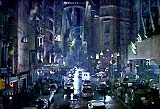 Example: Anton Furst's amazing, Oscar-winning Art Direction/Set Decoration of Gotham City in Batman (1989) Example: Anton Furst's amazing, Oscar-winning Art Direction/Set Decoration of Gotham City in Batman (1989) |
| production (value) | production refers to an entire movie project; pre-production refers to the stage at which a film is prepared to go into production; post-production refers to the stage at which editing, scoring and effects are executed on a motion picture; production value refers to the overall quality of a film, based not on the script, acting, or director, but on criteria such as costumes, sets, design, etc. | |
| projector | the machine that rapidly puts ('projects') a succession of motion picture images (individual frames) up onto a screen, using the principle of illusion of motion |
|







